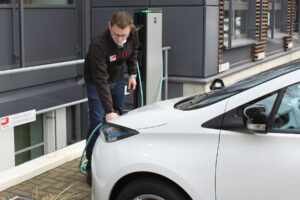 Also in the new year, there is a lot going on around and at IBC SOLAR. In this regard we are also continuing our blog series about our IBC SOLAR home system. While part 1 dealt with a rough overview of the entire system, the second part focused specifically on the installed storage system. We already reported that, especially with regard to our storage cluster, the constantly growing electric fleet of IBC SOLAR is a big factor. And that’s why today’s Part 3 will focus on the topic of e-mobility, wallboxes and charging columns. We also report on how we at IBC SOLAR are dealing with the greatly changing mobility of the future.
Also in the new year, there is a lot going on around and at IBC SOLAR. In this regard we are also continuing our blog series about our IBC SOLAR home system. While part 1 dealt with a rough overview of the entire system, the second part focused specifically on the installed storage system. We already reported that, especially with regard to our storage cluster, the constantly growing electric fleet of IBC SOLAR is a big factor. And that’s why today’s Part 3 will focus on the topic of e-mobility, wallboxes and charging columns. We also report on how we at IBC SOLAR are dealing with the greatly changing mobility of the future.
Electric cars at IBC SOLAR
Due to our many years of experience in the field of renewable energies, the topic of electromobility naturally did not pass us by. While our founder and CEO, Mr. Möhrstedt, already built a first e-car as a pioneer long before the large-scale traffic turnaround, we are also motivated today to bring our green electricity on the road. Both the number of cars in our company fleet that have a purely electric drive and the number of employees who privately afford their own e-car are growing. But our customers are also coming to us in Bad Staffelstein more and more frequently with their electric cars. And all these cars have one thing in common: they want to be charged at our facility.
Wallboxes and charging stations at the company headquarters
For several years now, it has therefore been possible for employees and customers of IBC SOLAR to recharge their batteries with green electricity directly on site at our company headquarters. Initially with just a few charging points, for admittedly few electric cars, we now have eight charging points directly in front of our company headquarters alone. Thus, in addition to a single-phase charging option in the form of a socket, we also offer a charging station with three charging points and four KEBA wallboxes with 22 kW charging power each. The KEBAs of the x-Series as well as the charging station from Hardy Barth all have the communication protocol OCPP1.6 and are therefore easy to connect to a backend.
Load management and billing
However, as of today, we do not use the backend for billing, because our management board decided early on that both employees and customers should receive the green electricity free of charge. What we have to do, however, due to the number of charging points alone, is load management. For this, we work with an energy management system from smart1 solutions GmbH. In addition to dynamic load management, this also allows us to prioritize individual charging processes. In this way, customers charge extra fast at our headquarter in order to start with as much range as possible after their business appointment.
Really Loved the second blog on the installed storage system !